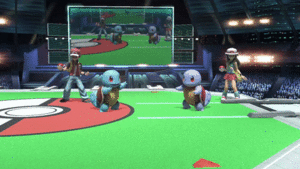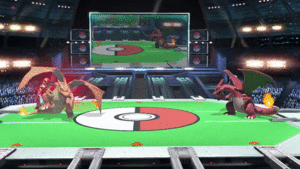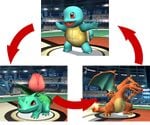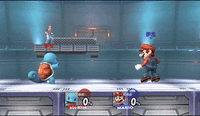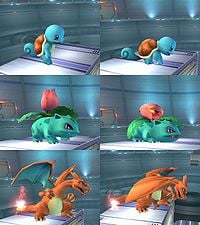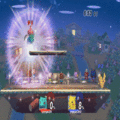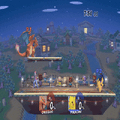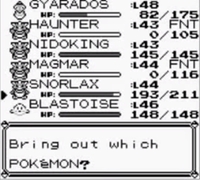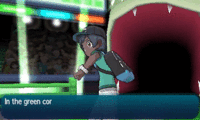Pokémon Change
- This article is about Pokémon Trainer's down special. For Zelda and Sheik's down special in Melee and Brawl, see Transform. For Pyra and Mythra's down special, see Swap.
| Pokémon Change | |
|---|---|
Pokémon Change in Ultimate | |
| User | Pokémon Trainer |
| Universe | Pokémon |
| Article on Bulbapedia | Recall |
Pokémon Change (ポケモンチェンジ, Pokémon Change) is Pokémon Trainer's down special move.
Overview[edit]
Pokémon Change is one of two moves that all three of the Trainer's Pokémon share, the other being their Final Smash, Triple Finish. Performing it changes the Pokémon from Squirtle to Ivysaur to Charizard in that order. However, only one Pokémon needs to be knocked out to score against Pokémon Trainer, and the next Pokémon in line will be called out on the revival platform.
Instructional quotes[edit]
| Call Squirtle back and swap it for a different Pokémon. Use a Pokémon for too long and it will tire. | ||
| Call Ivysaur back and swap it for a different Pokémon. Removing a tired Pokémon from battle lets it grow strong again. | ||
| Call Charizard back and swap it for a different Pokémon. Damage carries over to the next Pokémon. | ||
| Switches to Ivysaur. Immune to damage initially, but become vulnerable if used repeatedly. | ||
| Switches to Charizard. Immune to damage initially, but become vulnerable if used repeatedly. | ||
| Switches to Squirtle. Immune to damage initially, but become vulnerable if used repeatedly. |
In Brawl[edit]
If one Pokémon is KO'd, Pokémon Trainer will summon the next Pokémon in the rotation to the revival platform. Pokémon Change cannot be used again until the starting invincibility has worn off. Pokémon Change also cannot be used in midair.
While changing, there is a little time in which the Pokémon have invincibility frames. Thus the switching animation, which takes some time, can be used to "dodge" various attacks, most notably certain Final Smashes.
Notably, using Pokémon Change ends nearly all status effects on the Pokémon, both positive and negative. This includes super or mini size, Starman invincibility, metal form, Franklin Badges, Screw Attacks, etc. The exceptions to this rule are slowed-time, healing in progress, and Smash Ball readiness, all of which remain through the change. Any held item is immediately dropped.
Like Zelda's Transform, the next Pokémon to appear must be loaded from the disc before the switch can be completed. Pausing can shorten the in-game switch time (since the game loads during the pause), as can lag when online. If the switch time is artificially shortened as such, replays will temporarily freeze at the point the switch is made (since it must take the full time to load). Forcing the game to load the next character through an SD card via hacking will result in a near-instant switch time.
In Event 5: Become the Champion! and Co-Op Event 2: Master the Pokémon Tag Battle, this move will be disabled if the Pokémon Trainer loses two of his Pokémon, as both events eliminate any Pokémon that is KO'd.
Stamina[edit]
Stamina is a measure of how much energy the Pokémon Trainer's Pokémon have in Brawl.
At the start of a match, each Pokémon has 100 points of stamina. When a Pokémon is in battle, its stamina drops by half a point every second, resulting in 3 minutes and 20 seconds of stamina. Pokémon also lose half a point for every attack they attempt. Once a Pokémon's stamina drops below 40, its standing animation changes to look fatigued, and its attack damage is multiplied by 0.7 + (0.3 × Stamina ÷ 100), with a corresponding reduction in knockback. Thus the attack damage multiplier ranges from 0.779 to 0.7 as stamina decreases. Pokémon regain 0.8 points of stamina per second when not being used, requiring 2 minutes and 5 seconds to fully replenish. When a Pokémon is KO'ed, its stamina is set to 100 − (0.3 × (100 − previous stamina)), so it will be 70% closer to full. This has no effect on the other Pokémon.
The stamina mechanic hurts Pokémon Trainer's competitive usage. As a clear attempt to force players to use all of the Pokémon instead of sticking to one for an entire match, Pokémon Trainer mains are forced to learn three different characters and are penalized for using a single one for too long. This can also cause problems in matchups, where one Pokémon may hard counter a certain opponent, but the player cannot take advantage of this without suffering a significant strength reduction, giving the opponent openings to strike back. This contrasts with other transforming characters, such as Zelda and Sheik, who have no such penalties.
In The Subspace Emissary, stamina is removed, allowing exclusive usage of one Pokémon.
Zero switching[edit]
A technique known as "zero switching" can be performed on horizontally moving platforms, which allows a Pokémon to switch out while leaving the player free to react immediately after the next Pokémon is switched in. To perform the technique, the player must initiate Pokémon Change while standing on the edge of a platform that is moving out from under them (such as the left edge of the Smashville platform when it is moving right). If done properly, the next Pokémon will appear in the air, leaving the player free to immediately input any aerial action. The zero switch also gives Squirtle and Ivysaur two midair jumps instead of one upon reappearance. Zero switching is commonly used competitively to avoid the high ending lag that results from switching normally (since the move cannot be started in midair, but this technique allows it to at least be ended in midair).
In Ultimate[edit]
In Super Smash Bros. Ultimate, stamina is absent, allowing the use of one Pokémon without penalty. Pokémon Change can now be performed in mid-air and has a much faster switch time from not being subject to load times. This reduces the risk of switching Pokémon, greatly improving their synergy with one another. It also improves recovery options, as Charizard maintains its extra midair jump, and Ivysaur's Vine Whip no longer causes helplessness should it miss the edge. In exchange, Pokémon Change now has a cooldown of approximately two seconds and no longer resets stale move negation.
Pokémon Change grants intangibility frames on frame 1-25. This never changes despite the Skill List noting that spamming the move increases vulnerability.
Aesthetically, in a match with at least 5 players, in Squad Strike's Tag Team mode, or on Custom Stages, the Pokémon Trainer(s) will not appear on-screen - instead Poké Balls will be thrown and recalled from behind the screen.
Quick switch cancel[edit]
Quick switch cancel is a technique to skip Pokémon Change's two-second cooldown. By using a special move, Pokémon Trainer will do a pointing animation, which overrides his recall animation. This allows him to use Pokémon Change immediately afterwards without the cooldown. The quickest special move to use for each Pokémon is Squirtle's Water Gun charged then jump-cancelled, Ivysaur's Vine Whip, and Charizard's Flamethrower unheld. Ivysaur's Razor Leaf is practical for keeping a projectile in front of it, while being almost exactly as quick as Vine Whip. Vine Whip is helpful in mid-air to quick switch cancel from Squirtle to Charizard, as it does not cause helplessness. The rest of the special moves are less practical to quick switch cancel with, as they are either slow, too committal, or cause helplessness. Because the technique relies on overriding Pokémon Trainer's recall animation, the technique cannot be used if he is physically not on-screen (which occurs in matches with at least 5 players, in Squad Strike's Tag Team mode, and on Custom Stages).
Origin[edit]
While the phrase "Pokémon Change" itself is only an official term in the Japanese version, it describes the act of switching out a Pokémon mid-battle. It is a crucial tactic in the games, both in-game and competitively, and takes place before all other actions for that turn, unless the change was initiated by a move such as Baton Pass. Pursuit is an exception to this, as it is designed to counter switching. In the games, as switching takes up the user's turn, the benefits of switching in a Pokémon to face a target it is effective against must be weighed against the risks of being hit hard, setup on, or simply out-predicted by the opponent.
In the Pokémon games, switching out a Pokémon cures minor status effects and all temporary stat modifications, but major status effects (such as paralysis and sleep) will remain unchanged, and HP is tracked individually for each Pokémon. This can be compared and contrasted to Brawl, where the whole Pokémon team share the same damage, but a switched-out Pokémon regains stamina and has almost all status effects removed.
The concept of stamina as Brawl uses it does not exist in the Pokémon games. There is no mechanic that naturally makes a Pokémon weaker the longer it remains in play, unless one counts the fact that moves have limited uses and a single Pokémon used too long will eventually be unable to do anything. Even then however, these limited uses do not replenish while the Pokémon is switched out. It however resembles battles in the anime and manga where trainers switch out Pokémon to let the recalled Pokémon rest.
Gallery[edit]
Pokémon Trainer swapping his Pokémon on Pokémon Stadium 2.
Names in other languages[edit]
Trivia[edit]
- With precise timing, the invincibility frames during Pokémon Change can be used to avoid all three of Tabuu's Off Waves.
- In Brawl, only one character can be loaded at once, so if multiple Pokémon Changes or Transforms occur simultaneously, they must each wait for the previous one to complete.
- If two Pokémon Trainers are using the same palette swap (via team battle or a glitch), transforming into the other player's active character will be instant since the data is already active.
- In Brawl, if Pokémon Change is used in mid-air, the Pokémon Trainer will just stare down at his Poké Ball and toss it up in the air twice.
- This can also happen in The Subspace Emissary while the Trainer only has Squirtle, or on the last stock in the Become the Champion! event as KO'd Pokémon are unavailable.
- Another instance of this happening in The Subspace Emissary is while the Trainer is left outside the elevator, where he will not respawn until some floors below; but even once he does respawn, switching is unavailable.
- In Brawl, the Poké Balls used in the move are smaller and darker in color than the Poké Ball item, likely to prevent confusion between the two.
- Pokémon Change is the only transformation move to return in Ultimate.
- If the trainer is not on-screen while a change occurs, a Poké Ball is thrown from the foreground instead of the background.
